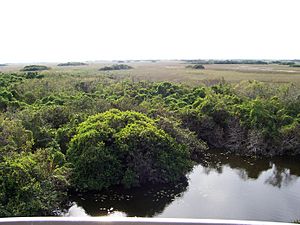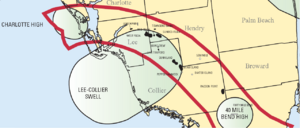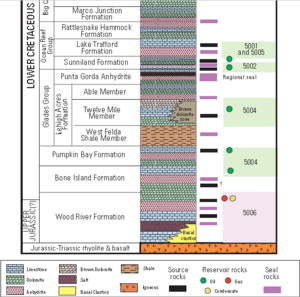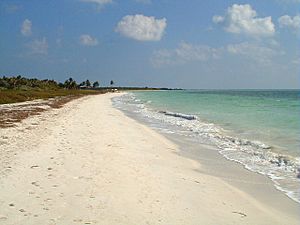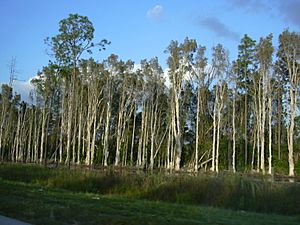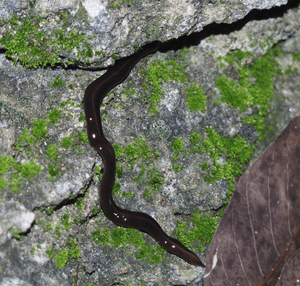Environment of Florida facts for kids
Florida's environment is amazing! It has many different kinds of plants and animals, thanks to its warm, subtropical climate. This beautiful environment has attracted millions of people to live here over the last 100 years. Florida's population grows by about 1,000 people every day. This growth has changed the state a lot, especially by draining and filling in the wetlands that once covered most of Florida.
Much of Florida is made of limestone rock with water-filled caves and sinkholes. These underground spaces are home to many unique water creatures. As cities and towns have grown, people need more water from underground. This has damaged parts of the cave system, causing the ground to sink when dry caves collapse. This can threaten buildings and natural habitats.
Protecting and restoring the Everglades is a top environmental goal in Florida. In 2000, the U.S. Congress started the Comprehensive Everglades Restoration Plan. This huge project costs $7.8 billion and will take 30 years. Its goal is to save and restore the Everglades and its special environments.
By 2018, about 30% of Florida's land was set aside for conservation.
Contents
Florida's Environmental Story
How Florida Grew and Changed
In 1900, Florida had only four cities with more than 5,000 people: Jacksonville, Pensacola, Key West, and Tampa. The total population was just over 500,000. The southern part of the state was mostly empty marshlands. Some people tried to drain water from Lake Okeechobee in the 1880s. But big changes didn't happen until Governor Napoleon B. Broward was elected in 1904. He promised to drain the Everglades and sell the land.
From 1906 to 1913, over 225 miles (362 km) of canals were dug. These included the Miami Canal and others. A bigger plan followed, building 440 miles (708 km) of canals, 47 miles (76 km) of levees, and 16 locks and dams between 1913 and 1927. As land was drained, farmers moved in. Huge farms appeared in southeastern Florida. The "Florida land boom" of the 1920s also encouraged more building. This boom ended in 1926. Growth slowed until World War II.
After World War II, many people moved to Florida. The population jumped from 1.9 million in 1940 to 2.8 million in 1950. Areas like Tampa Bay and South Florida grew the most.
By 1945, a long dry spell showed the problems of changing the environment. Saltwater started getting into wells in southern Florida. Big wildfires destroyed farms and fertile soil. From the 1940s to the 1970s, the state and federal governments began using controlled burns. This helped prevent uncontrolled fires. In 2010, Florida burned a record 2.6 million acres (10,522 km²) in controlled burns.
In 1947, 90% of Florida south of Orlando was underwater due to heavy flooding. This showed that the drainage projects were not working well for anyone. That same year, Everglades National Park was created. Also, Marjory Stoneman Douglas published her book The Everglades: River of Grass. It warned about the harm done to the delicate ecosystem. The next year, Florida created the agency that became the South Florida Water Management District. This group manages water quality, flood control, and environmental restoration in 16 counties.
To stop flooding, the Kissimmee River was straightened between 1962 and 1970. This project did prevent floods. But it also destroyed many natural habitats that depended on the river's floodplains. Many threatened and endangered species were harmed. Over 90% of the water birds disappeared, and bald eagle nests dropped by 70%. The river became a straight, deep canal with less oxygen, changing the fish living there.
During the 1960s and 1970s, continued growth along Florida's coasts and Interstate 4 put more stress on the environment. Parts of Big Cypress Swamp were drained for building. But then, Big Cypress National Preserve was created in 1974. More land was added to Everglades National Park in 1989. In 2000, Congress passed the Comprehensive Everglades Restoration Plan (CERP). It aims to restore and protect the south Florida ecosystem. This plan is a huge effort between federal, state, and local governments. It covers 18,000 square miles (46,620 km²) across 16 counties. It's expected to take 30 years and cost about $7.8 billion.
As Southeast Florida became more developed, growth moved to rural areas in central and north Florida. From 2000 to 2006, Flagler County was the fastest-growing county in the U.S. This fast growth has harmed the Guana Tolomato Matanzas National Estuarine Research Reserve. It also threatens wildlife like manatees and bears, and affects the region's water supply.
Studies show that Florida is one of the states that will face the worst economic and environmental impacts from climate change.
Water Resources
Florida gets most of its drinking water from underground sources like the Floridan Aquifer and the Biscayne Aquifer. It also uses surface water from Lake Okeechobee and other lakes. But as the population grows, these sources are becoming strained. Florida has built 120 desalination plants. These plants remove salt from saltwater to make it drinkable. This is more than three times as many as any other state. Florida also has the largest desalination plant in the U.S.
Florida's Energy Story
Florida uses less energy per person than most states. This is true even though many people use air conditioners and pool pumps. Florida gets its energy from coal, natural gas, petroleum, and electricity. Only about 4% of the state's energy comes from renewable sources. Florida produces 6% of the nation's total energy. It also produces less pollution compared to its energy output.
In 2007, Florida Governor Charlie Crist announced plans to set strict new air-pollution rules. The goal was to cut greenhouse-gas emissions by 80% of 1990 levels by 2050. These rules would set new targets for power companies, cars, and trucks. They would also require state agencies to save more energy and use alternative fuels for state vehicles.
Governor Charlie Crist and Florida's senators, Bill Nelson and Mel Martinez, were against offshore drilling for oil and gas. Former governor Jeb Bush changed his mind about a bill in 2005. This bill would allow drilling 125 miles (201 km) or more from the coast. Martinez, Nelson, and Crist were against that bill. But Martinez and Nelson voted for a different Senate bill. This bill stopped drilling within 125 miles (201 km) of the Panhandle coast and 235 miles (378 km) of the peninsular coast.
In 2006, Florida started the "Farm to Fuel" program. This program aims to make more renewable energy from crops and farm waste grown in Florida. In 2008, Florida's Agriculture Commissioner announced funding for four new ethanol and biodiesel plants. They also funded eight research projects.
Oil and Gas Exploration
Florida has two main areas where oil is found. One is in South Florida, with 14 oil fields. The other is in the western Panhandle, with seven fields. The South Florida fields are in Lee, Hendry, and Collier counties. Florida's first oil field, the Sunniland field, was found in Collier County in 1943. It has produced over 18 million barrels of oil. The three Felda fields in Hendry County have produced over 54 million barrels of oil.
Oil production in the western Panhandle began with the discovery of the Jay field in 1970. Jay is one of the most important oil fields found in the U.S. since 1968. Another important discovery was the Blackjack Creek field. Oil comes from the Jurassic Smackover Formation.
Six more oil fields have been found in the western Panhandle since then. North Florida has produced most of Florida's oil since the Jay field was discovered. North Florida oil fields account for 83% of the state's total oil production. The Jay field alone is responsible for 71% of the state's total.
It is believed that there are large energy resources off Florida's western coast in the Gulf of Mexico. However, this area has been closed to exploration since 1981.
Waste Management in Florida
Finding enough space for landfills is a growing problem. St. Lucie County plans to try burning trash using plasma arc gasification. This process turns trash into energy and greatly reduces the amount of waste. This experiment will be the largest of its kind in the world. If it works, experts believe the entire St. Lucie County landfill, with 4.3 million tons of trash, could disappear in 18 years. The materials left over from energy production can also be used to build roads.
Recycling Efforts
In 2000, Florida's recycling rate was about 28%. Lee County had the highest recycling rate in 2008, at 43%.
Florida's Energy, Climate Change, and Economic Security Act of 2008 set a goal to improve recycling. The aim is to reach a 75% recycling rate by 2020. This law requires public places like schools and government agencies to report how much they recycle each year. Private businesses are encouraged to do the same. The law also created a Recycling Business Assistance Center.
Under this new law, each county must have a recycling program. Their goals are to recycle 40% of solid waste by 2012, 50% by 2014, 60% by 2016, 70% by 2018, and 75% by 2020.
Parks and Beaches
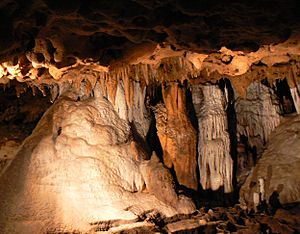
In 2017, about half of Florida's sandy beaches were eroding, meaning they were losing sand. About half of these eroding beaches were being helped by beach restoration projects.
The National Park Service manages several important areas in Florida:
- Big Cypress National Preserve, near Lake Okeechobee
- Biscayne National Park, south of Miami
- Canaveral National Seashore, near Titusville
- Castillo de San Marcos National Monument, in St. Augustine
- De Soto National Memorial, in Bradenton
- Dry Tortugas National Park, at Key West
- Everglades National Park in Southern Florida
- Fort Caroline National Memorial, at Jacksonville
- Fort Matanzas National Monument, in St. Augustine
- Gulf Islands National Seashore, near Gulf Breeze
- Timucuan Ecological and Historic Preserve, in Jacksonville
The United States Forest Service manages these national forests:
- Apalachicola National Forest
- Choctawhatchee National Forest near Niceville
- Ocala National Forest in Central Florida
- Osceola National Forest in Northeast Florida
The National Oceanic and Atmospheric Administration (NOAA) protects one special ocean area:
- Florida Keys National Marine Sanctuary
Florida's Amazing Biodiversity
Florida is a state with many different kinds of life, known as biodiversity. It has 3,500 native plants and 1,500 types of vertebrates (animals with backbones). This is more than all but three other U.S. states. A 2003 study found that the Florida Straits had the most biodiversity in the Atlantic Ocean. It is home to 25 species found nowhere else in the world.
Flora (Plants)
In 2005, Red tide was a problem on Florida's southwest coast. Red tide is a harmful algae bloom. While people have wondered if pollution causes it, there's no clear proof that pollution increases how often or how long red tides happen.
Before controlled burns were common, Florida's forests and pastures would burn for months during the dry season. From the 1940s to the 1970s, state and federal governments took charge of burning. This helped prevent large, uncontrolled fires. In 2010, Florida burned a record 2.6 million acres (10,522 km²) in controlled burns.
Fauna (Animals)
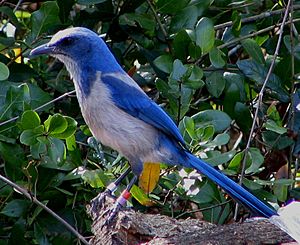
Some animals found only in Florida are the Florida scrub jay, the Miami blue butterfly, the Okaloosa darter fish, and the Key deer.
Florida is a popular place for birdwatching. Many different bird species can be seen here throughout the year. The Florida Ornithological Society keeps an official list of Florida birds, which has 498 species. A 2003 study found that 196 bird species were confirmed to breed in Florida. The Great Florida Birding Trail is a 2,000-mile (3,200 km) long trail with 489 great spots to watch birds.
Sport fishing is also very popular in Florida. Over 250 different fish species can be found in Florida's waters, including 73 non-native species. There are more than 1,000 fish species in Florida's coastal waters.
In 2010, NOAA banned fishing for red snapper for a while. This was done to allow the fish population to recover.
Florida's Atlantic coast has the only large coral reefs in the continental United States. They are the third largest in the world. The entire reef system in the Florida Keys is protected as part of the Florida Keys National Marine Sanctuary. Large parts of the reef are also protected in Biscayne National Park.
In 1977, the federal government listed alligators as endangered. They were removed from the endangered list in 1987. Florida then allowed limited hunting of alligators starting in 1988.
Bird and Turtle Habitats
In 1987, the last dusky seaside sparrow died in Florida. This bird is now extinct. This sad event showed how important it is to protect other endangered species quickly.
The Florida scrub jay has been considered threatened for many years. This is because these birds stay in their own areas. They cannot easily move to new places if their habitat is in danger.
Beaches where loggerhead sea turtles lay their eggs are protected to help these turtles survive.
Environmental Challenges
Invasive Species
Florida's native plants are threatened by many invasive plants. One example is the Brazilian pepper tree. It is illegal to own or grow this tree. Many volunteers regularly cut down these invading plants, especially near waterways. The Australian pine is also being controlled to stop its spread.
Other foreign pests include the Asian ambrosia beetle. This beetle threatens Florida's avocado industry and redbay trees.
It is illegal to bring giant African land snails into Florida. These snails can harm buildings, 500 types of local plants, and can carry diseases like meningitis.
In 2015, a land flatworm called Platydemus manokwari was found in Miami. This is a very invasive species. It eats snails and is a threat to Florida's biodiversity.
Climate Change
The effects of climate change in Florida are happening because of more carbon dioxide in the air, mostly from human activities. People in Florida are seeing more flooding as sea levels rise. They also worry about hurricanes becoming stronger or happening more often.
Florida is often called "ground zero" for climate change. This is because many people and businesses are located very close to the low-lying coastlines. More Floridians believe that climate change is happening compared to the national average. As of 2023, about two-thirds of the state thinks that human actions cause climate change. This is up from 55% in 2020.
However, opinions are still divided. Most Democrats agree on the issue. But only about half of Republicans agree and support teaching about climate change in schools. Some Florida communities are trying to deal with climate change. But statewide efforts have been slow because of political disagreements. The focus has been more on being ready for changes (resilience) rather than stopping climate change (mitigation) or fully adjusting to it (adaptation).

